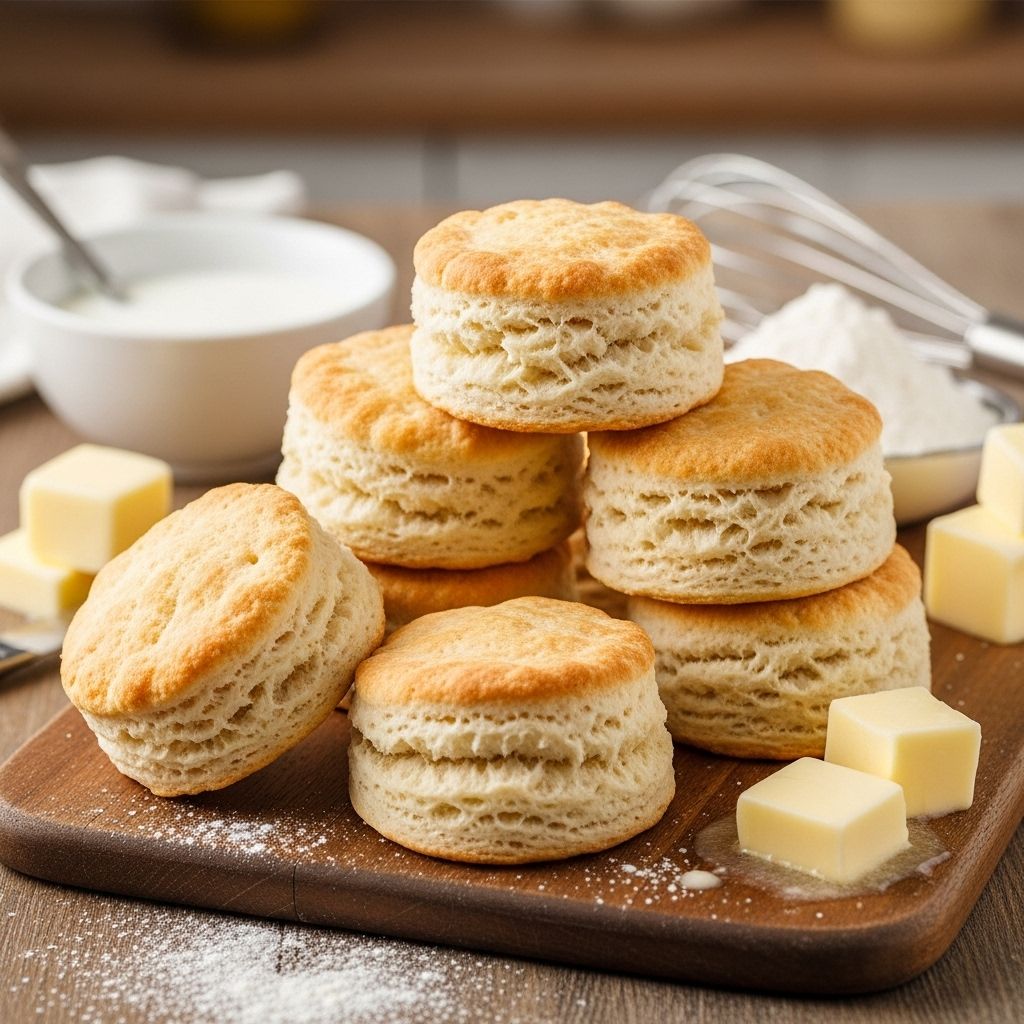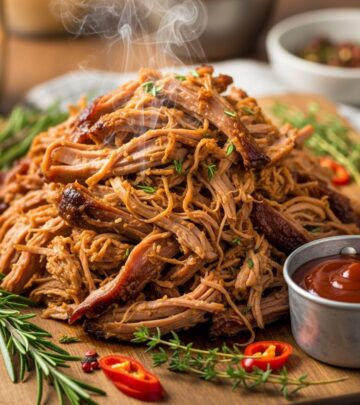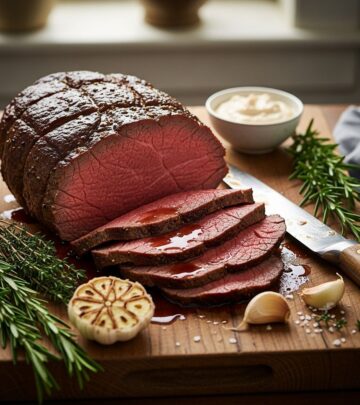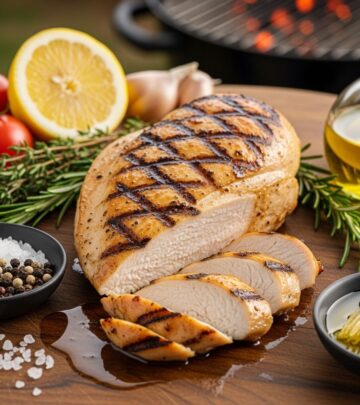Gluten-Free Buttermilk Biscuits: The Complete Guide
Smart techniques and ingredient tweaks ensure tall rise with buttery, flaky layers.

Few experiences match the satisfaction of biting into a freshly baked, tender biscuit— and the best recipes ensure even those who need or prefer gluten-free options can enjoy this classic comfort. This guide explores every detail of gluten-free buttermilk biscuits, including expert baking tips, ingredient breakdowns, troubleshooting, substitutions, and frequently asked questions. Whether you’re a seasoned baker or new to gluten-free recipes, this comprehensive approach will help you achieve biscuits as light, flaky, and flavorful as their wheat-based counterparts.
Why Make Gluten-Free Buttermilk Biscuits?
- Bake for Everyone: Sharing biscuits with friends and family—including those with celiac disease or gluten sensitivities—opens doors for more inclusive meals.
- Improved Ingredients: Modern gluten-free flour blends and baking strategies deliver structure and taste once thought possible only with wheat.
- No Compromise on Texture: By following key techniques and ingredient ratios, you can produce biscuits with a delicate crumb, golden top, and satisfying rise.
Ingredients for Gluten-Free Buttermilk Biscuits
Gluten-free buttermilk biscuits thrive on balance. Each ingredient plays a vital role:
- Gluten-Free Flour Blend: A high-quality all-purpose blend ensures structure. Some blends include xanthan gum (for binding); if absent, add 1/2 tsp for every 2 cups of flour used.
- Baking Powder & Baking Soda: These leavening agents supply lift and tenderness. Gluten-free recipes often require a bit more baking powder to compensate for the absence of gluten’s stretch.
- Salt: Essential for flavor development and balance.
- Butter: Cold butter is the cornerstone for flakiness. Its fat content creates steam pockets as it melts, yielding soft layers.
- Buttermilk: Full-fat buttermilk imparts distinct tang and structure. For dairy-free baking, use unsweetened milk alternatives mixed with lemon juice or vinegar (see substitutions below).
- Eggs: Eggs lend richness and help stabilize the crumb.
Common Ingredient Measurements
| Ingredient | Typical Amount | Purpose |
|---|---|---|
| Gluten-Free All-Purpose Flour | 2–4 cups (250–560g) | Base structure |
| Xanthan gum | 1/2 tsp per 2 cups (if blend lacks) | Texture/binding |
| Baking Powder | 1–4 tbsp | Leavening agent |
| Baking Soda | 1 tsp | Acid balance/rise |
| Salt | 1 tsp | Flavor |
| Butter | 6 tbsp to 3 sticks, cold | Fat/flakiness |
| Buttermilk | 1–2 cups, cold | Moisture, acid |
| Egg | 1–2, cold | Richness, structure |
How To Make Gluten-Free Buttermilk Biscuits: Step-By-Step
1. Prepare Ingredients
- Gather all dry ingredients: gluten-free flour blend, baking powder, baking soda, salt. Whisk thoroughly in a large bowl for even distribution.
- Cut cold butter into 1/4-inch slices; return to refrigerator or briefly freeze to maintain firmness.
- Mix buttermilk and eggs together in a measuring jug for even blending. If making dairy-free, add lemon juice or vinegar to milk alternative and allow to chill.
2. Cut Butter Into Flour
- Add cold butter to dry ingredients. Using a pastry blender, fork, or clean fingers, work the butter into the flour until the mixture resembles coarse crumbs and small pea-sized bits remain.
- Aim for visible chunks of butter—these will yield flaky layers during baking.
3. Add Liquids, Form Dough
- Pour buttermilk–egg mixture into flour–butter mixture.
- Gently stir just until a sticky, wet dough forms. Avoid over-mixing; excessive agitation develops toughness even with gluten-free flours.
- Cover and refrigerate for at least 30 minutes, or up to 24 hours. Chilling firms the fat and hydrates the flour, improving rise and texture.
4. Shape and Cut Biscuits
- Turn chilled dough onto a lightly floured surface.
- Knead briefly to bring together, then pat or roll into a slab about 1 inch thick.
- Use a floured biscuit cutter (or mason jar lid) to cut biscuits. Press straight down; twisting seals edges and can inhibit rise.
- Arrange biscuits shoulder-to-shoulder on a greased baking sheet or pan. This encourages upward lift and tenderness.
5. Bake
- Brush biscuit tops with melted butter for golden color and extra flavor.
- Bake in a preheated 400–450°F oven until tops are golden brown and biscuits have risen tall, typically 15–30 minutes.
- Cool briefly; serve warm for best texture.
Essential Tips for Success
- Use Cold Ingredients: Chilled butter and buttermilk are crucial; warmth melts fat prematurely, reducing flakiness.
- Don’t Overwork Dough: Stir just until combined and briefly knead. Over-mixing forms tough, flat biscuits.
- Chill Dough Before Baking: Refrigeration helps biscuits retain shape in the oven, maximizing lift.
- Arrange Biscuits Touching: Baking biscuits close together creates steam, ensuring a soft, fluffy texture.
- Brush With Butter: Adds flavor and moisture to the finished biscuit.
Gluten-Free Biscuit Substitutions and Variations
Flour Blends
Not all gluten-free blends behave identically. Those based on rice flour, potato starch, tapioca, and sorghum are favored. Some commercial blends contain xanthan gum; if not, as a general guideline, add 1/2 tsp per 2 cups flour for structure.
Butter Alternatives
- For dairy-free or vegan biscuits, use plant-based butter like Smart Balance or Earth Balance, or vegetable shortening.
- These alternatives maintain flakiness; note that shortening produces slightly different texture and flavor.
Egg Replacements
- Use commercial replacers (such as Bob’s Red Mill Egg Replacer) or homemade substitutes (1 tbsp ground flaxseed + 3 tbsp water) for an egg-free dough.
- Egg omissions may make biscuits less rich or less structured, but still taste excellent.
Buttermilk Substitutes
- Combine 1 cup unsweetened vegan milk (almond, cashew, or coconut) with 1 tbsp lemon juice or vinegar. Let stand 5–10 minutes to sour and chill before use.
- Reduced fat or nondairy buttermilk may require less liquid to achieve proper dough stickiness; adjust as needed.
Troubleshooting Gluten-Free Biscuit Issues
- Biscuit Too Flat: Make sure baking powder is fresh and dough isn’t rolled out too thin. Cut biscuits at least 1 inch thick and don’t twist the cutter.
- Dry Biscuits: Reduce flour slightly or add a touch more buttermilk. Gluten-free flours are more drying than wheat.
- Gummy Texture: Don’t overmix liquids; chill the dough thoroughly before shaping and baking.
- Crumbly Biscuits: Make sure to include xanthan gum if your flour lacks it. A touch more fat (butter or oil) can also improve moisture and structure.
Serving & Storage Suggestions
- Serve warm, split and filled with butter, jam, honey, or topped with sausage gravy for a classic Southern breakfast.
- Biscuits make a perfect base for breakfast sandwiches, strawberry shortcake, or as a side for savory stews and chili.
- Store cooled biscuits in an airtight container at room temperature for up to 2 days. For longer storage, freeze biscuits in a sealed bag for up to a month and reheat in a low oven.
Frequently Asked Questions (FAQs)
Q: Can I use any gluten-free flour blend?
A: You can use most high-quality, all-purpose gluten-free flour blends. However, results vary between brands due to different starches and gums. Always check for xanthan gum in the blend and add if needed.
Q: Is xanthan gum necessary?
A: Yes, unless your flour blend includes it. Xanthan gum mimics gluten’s binding and elasticity, helping your biscuits hold together instead of crumbling.
Q: Can I make these biscuits dairy-free or vegan?
A: Absolutely. Use vegan butter, plant-based milk with vinegar or lemon juice as buttermilk substitute, and egg replacer or omit egg for a fully vegan option.
Q: Why chill the dough?
A: Chilling ensures the butter remains solid, which creates steam and layers during baking for a super flaky texture.
Q: How do I avoid tough biscuits?
A: Handle the dough gently and do not overmix. Once liquids are incorporated, minimal kneading helps prevent dense biscuits.
Q: How do I store leftovers?
A: Store in an airtight container at room temperature up to 2 days, or freeze for longer storage. Reheat gently in the oven to restore crispness.
Expert Insights: Secrets to Perfect Gluten-Free Biscuits
- Butter Size Matters: Visible, uneven butter pieces in the dough are key to classic biscuit texture.
- Mimic Self-Rising Flour: Blend baking powder, baking soda, and salt with gluten-free flour to create a substitute for self-rising flour.
- Don’t Skip Chilling Twice: Refrigerate the dough before shaping, and the cut biscuits before baking. Each chill period aids loft and texture.
- Biscuits Should Touch in the Pan: This encourages vertical rise and soft edges, as opposed to spreading out and crisping.
Summary Table: Key Gluten-Free Biscuit Steps and Tips
| Step | Technique | Result |
|---|---|---|
| Mix Dry Ingredients | Thorough whisking | Even flavor/leavening |
| Cut In Cold Butter | Use pastry blender/fingers | Flaky, layered biscuit |
| Add Buttermilk & Egg | Gentle stirring | Moist, tender crumb |
| Chill Dough | Refrigerate 30 min+ | Max loft, texture |
| Shape & Cut Biscuits | Pat/roll, straight-down cut | Thick, tall biscuits |
| Bake Close Together | Arrange biscuits touching | Soft, lofty results |
| Brush With Butter | After baking | Golden top, extra flavor |
Conclusion: Making Gluten-Free Buttermilk Biscuits a New Classic
Gluten-free buttermilk biscuits aren’t simply an adaptation—they’re a showcase for smart technique and quality ingredients. With the right flour blend, chilled butter, and balanced moisture, gluten-free bakers can achieve biscuits that are soft, flaky, and flavorful enough to satisfy any palate. Master the method—and the substitutions—and you’ll have a go-to recipe for buttery biscuits that everyone will request again and again.
References
Read full bio of medha deb












